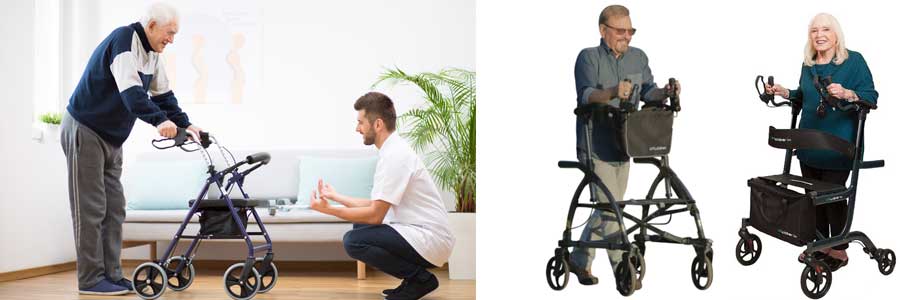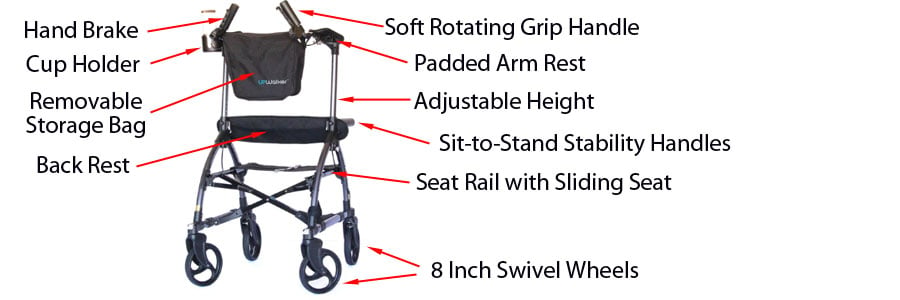
Updated: February 15, 2022
Top Five Benefits of an Upright Rollator Walker
#1 Reduces Stress
Using standard walkers forces most mobility patients to bend over to reach the grips and move forward. In this unnatural manner, bending the body is poor posture and very stressful to the body's major joints. Prolonged use of standard walkers can cause many complications that deteriorate health and wellbeing. The use of an upright walker, on the other hand, supports mobility and continued exercise to improve wellbeing.
#2 Decreases Pain
Slouching over a walker is painful. Most people avoid activities that cause pain. When pain occurs, people often avoid the endeavor that produces it. Physical therapists teach that motion is lotion to the joints. Being physically active helps to keep joints from getting stiff and painful. Avoiding tasks like moving from one place to another exacerbates joint deterioration and further reduces mobility. In this manner, pain causes more pain by further reducing joint flexibility. The goal is to continue to engage in as much activity as possible to keep joints exercised and flexible. Using an upright rollator that supports an erect profile reduces pain and keeps mobility patients healthier. Continued walking and physical activity slows the aging process and helps keep people happy and active.
#3 Walk Farther, Walk Longer
Mobility patients that can maintain a proper upright walking posture can walk farther. A standup walker reduces stress and pain, allowing the user to walk with less discomfort. Reducing pain and stiffness promotes users to achieve longer distances. The time spent on foot traffic increases over a standard walker because they experience less stress and less aching.
#4 Provides Safer Mobility
Stand up rollators serve as lateral support walkers that help the user keep their head up to identify upcoming obstacles. Many standard walker users walk with their heads down while leaning forward to maintain a steady hold on the handgrips. Unable to look forward enough to see approaching obstructions often leads to accidental falls. While leaning forward, users are somewhat off-balance and produce additional stress on their lower back, wrists, and shoulders. Walking upright keeps the user's body weight centered and more balanced.
#5 Promotes User Independence
Upright walkers are forearm support walkers that allow the user to stroll without the assistance of a caregiver. Users have the freedom to wander around the neighborhood, talk with neighbors while standing or sitting, and shop at a nearby market. The devices allow for more user autonomy to go where they want to go and when they want since they are not dependent upon assistance.
An upright walker is a standing rollator or forearm support walker that supports the user while engaged in foot traffic. These upright walkers for seniors come with four legs, each equipped with a swivel-type wheel for high maneuverability. They differ significantly from standard rollators or rolling walkers. The top of the frame extends upward to support the forearms and help the user maintain an upright position while walking. Medical studies find that these upright rollators offload body weight from the lower extremities where load-bearing diminishes with age. These standing rollator walkers improve gait efficiency during ambulation and reduce trunk sway. Another finding shows that standup rollators reduce erector spinae muscle activation at the left lumbar L3. Study participants offload between 39 to 46 percent of their body weight through the elbow support armrests when walking with a stand up straight rollator.1
This article reviews the utility of upright rolling walkers and their role in supporting aging seniors and the disabled. The report also examines the question of why someone should buy this type of mobility device.
As people age, their mobility becomes restricted, forcing them to rely upon canes, walkers, and wheelchairs to continue their mobility. Mobility restrictions contribute significantly to a loss of autonomy as caregivers swoop in to assist. The transition to motorized assistance and caregiver support further degrades their independence. Studies conclude that delaying caregiver and motorized aid is in the best interest of mobility patients. Self-ambulation, joint motion, and muscular exercise are crucial for maintaining gait, patient independence, and a healthy lifestyle.2, 3
Aging seniors often find themselves bent-over their standard walkers while engaged in pedestrian foot traffic. This slouching is the result of deteriorating muscles and joints. Mobility patients find it more demanding and challenging to maintain an upright posture when traversing down sidewalks or walkways. Standard walkers, with their low profiles and small wheel size, make standing upright even more difficult. An upright walker for the elderly helps alleviate this slumped position to keep the user in a stand-up posture on-foot treks.
What Is an Upright Walker
An upright walker is a standup rollator that supports mobility patients in maintaining an active lifestyle. The design of these devices allows the user to walk upright instead of slouching over. They promote good posture for users that standard walkers or rollators cannot adequately sustain. These devices keep the user's back straight while walking or standing. They reduce hunching over or leaning. A stand up rollator provides safe, independent walking assistance for users with a weakened torso or back injury. In summary, these mobility aids help users to stay active and healthy longer.
Why Use an Upright Rollator Walker?
As people age, walking becomes more difficult because joints become stiffer, and muscle strength declines. Arm and wrist resilience weakens. Maintaining a good posture while walking grows more difficult. Aging diminishes motor control and cognitive functioning. Aches and pains become chronic. A walker that can help keep the user in an upright walking position can prolong mobility and promote healthier outcomes.
Top Features of an Upright Walker Rollator
Advantages At a Glance
- Greater Walking Stability
- Decreases Fall Risk
- Helps Prevent Slouching
- Keeps the User Upright
- Users Can Walk Faster and Farther
- Diminishes Stress on Joints and Muscles
- Promotes Increased Activity
- Keeps the User Facing Forward and Looking Up
- Provides More Awareness of Upcoming Obstacles
- Reduces Pain
- Keeps Users Active and Independent
- Promotes a Healthier Lifestyle
This article reviewed the utility of stand-up walkers. It analyzed the role of upright rollator walkers in supporting seniors and the mobility disabled. In summary, upright walkers provide extensive user support to maintain the dignity and lifestyle of the elderly. They keep users walking upright safely, farther, and longer than other alternatives. Anyone ready to buy an upright walker will want to consider the most sought-after version currently for sale--the UPWalker. The UPWalker is so popular that many competitors copy many of its features and foreign companies attempt to duplicate it with cheaper materials, exporting them for sale in the USA. Another stand up rollator to consider is a sister product from the same manufacturer, LifeWalker Mobility, called the UPWalker Lite. The lightweight version takes off eight pounds of weight and shifts the storage bag to a lower position.
Footnotes
- 1 Jayaraman, C., Mummidisetty, C. K., Loesch, A., Kaur, S., Hoppe-Ludwig, S., Staat, M., & Jayaraman, A. (2019). Postural and metabolic benefits of using a forearm support walker in older adults with impairments. Archives of physical medicine and rehabilitation, 100(4), 638-647. (Last Accessed December-24-2020)
- 2 Kuys, Suzanne S., et al. Gait speed in ambulant older people in long term care: a systematic review and meta-analysis. Journal of the American Medical Directors Association 15.3 (2014): 194-200. (Last Accessed October-2-2020)
- 3 Bateni, Hamid, and Brian E. Maki.Assistive devices for balance and mobility: benefits, demands, and adverse consequences. Archives of physical medicine and rehabilitation 86.1 (2005): 134-145. (Last Accessed October-2-2020)



Login and Registration Form